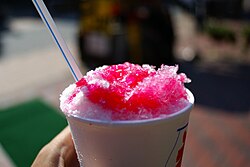Snow cone
 | |
| Type | Shaved ice |
|---|---|
| Variations | Granita |
A snow cone is a variation of shaved ice or ground-up ice desserts commonly served in paper cones or foam cups.[1] Although if it is in a cup, it is commonly referred to as a "snow-cone". The dessert consists of ice shavings that are topped with flavored sugar syrup.
Depending on the region of North America, the terms "snowball", “ice cone” and "snow cone" may refer to different things. Where the distinction is made, the former refers to a dessert made of finely shaved ice ("like soft fresh snow"), while the latter contains ground-up ice that is coarser and more granular ("crunchy").
History[]

Industrial Revolution[]
In the 1850s, the American Industrial Revolution made ice commercially available in the United States. Ice houses in New York would commonly sell ice to states like Florida. To transport the ice to Florida, the ice houses would send a wagon with a huge block of ice south. The route to Florida would pass right through Baltimore where children would run up to the wagon and ask for a small scraping of ice. Before long, mothers started to make flavoring in anticipation of their children receiving some ice. The first flavor the women made is still a Baltimore favorite: egg custard. Egg custard was an easy flavor to make as the only ingredients were eggs, vanilla, and sugar.[2]
Theaters[]
By the 1870s, the snowball's popularity had risen to the degree that in the warm summer months, theaters would sell snowballs to keep their patrons cool. Because of this association with the theater, snowballs were thought of as an upper-class commodity. Signs in theaters instructing patrons to finish their snowballs before coming in to the second act are the earliest tangible evidence of snowballs. In the theaters in Baltimore during the time hand shavers were used to shave the ice. Around the city, snowballs were served on newspaper, but in the classy theaters, butchers' boats[definition needed] were used. In the 1890s, many people started to invent easier ways to make snowballs. In that decade, patents for electric ice shavers were filed.[3][4]
Great Depression and World War II[]
During the Great Depression and World War II, snowballs became available outside of Baltimore. As snowballs were so cheap, they were one of the few treats that people could afford. This inexpensiveness earned snowballs the nicknames Hard Times Sundae and Penny Sunday. People in need of a job could sell snowballs, as it required little overhead. The treat became more popular during World War II, when all available ice cream was sent to soldiers, creating a need for an icy treat. This newfound lack of competition helped snowballs become popular across the country.[5]
See also[]
- Shaved ice § Regions, for similar shaved ice variations around the world.
- Italian ice - water ice
- Maple taffy - a Quebec and New England treat of boiled maple sap poured on snow
- Slush / Slushie - a shaved ice drink
- Icee - brand-name product
- Slurpee - brand name
- Slush Puppie - brand name
- Snow cream - a cream or snow and dairy-based dessert
References[]
- ^ "Carnival Scenes". St. Petersburg Independent. 26 October 1968. p. 6. Retrieved 30 November 2011.
- ^ Gienow, Michelle. “Cold Comfort: On the Cultural Significance of the Snowball in Baltimore” City Paper. September 18, 1996. Retrieved January 20, 2011.
- ^ Zay, Libby. "Summer in Baltimore: Snowballs Are the Essential Sweet Treat in Charm City". about.com. Archived from the original on 2017-03-13. Retrieved 25 November 2015.
- ^ Mayhugh, Jess. "The Snowball: A Baltimore Summer Classic". Serious Eats. Retrieved 25 November 2015.
- ^ Arnett, Earl “Tracing the Origin, Spread of Snowballs.” Baltimore Sun. 3 Aug. 1977, B1.
- Brands that became generic
- Ice-based desserts
- Maryland cuisine
- Cuisine of Baltimore